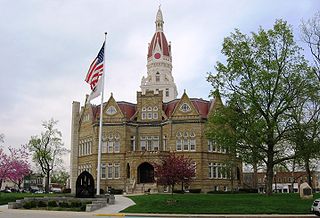
Pittsfield is a city in and the county seat of Pike County, Illinois, United States. The population was 4,576 at the 2010 census, an increase from 4,211 in 2000.

Lincoln's New Salem State Historic Site is a reconstruction of the former village of New Salem in Menard County, Illinois, where Abraham Lincoln lived from 1831 to 1837. While in his twenties, the future U.S. President made his living in this village as a boatman, soldier in the Black Hawk War, general store owner, postmaster, surveyor, and rail splitter, and was first elected to the Illinois General Assembly.
Mordecai Lincoln was an uncle of U.S. President Abraham Lincoln. He was the eldest son of Captain Abraham Lincoln, a brother of Thomas Lincoln and Mary Lincoln Crume, and the husband of Mary Mudd. Lincoln is buried at the Old Catholic or Lincoln Cemetery near Fountain Green, Illinois.
The Illinois Historic Preservation Division, formerly Illinois Historic Preservation Agency, is a governmental agency of the U.S. state of Illinois, and is a division of the Illinois Department of Natural Resources. It is tasked with the duty of maintaining State-owned historic sites, and maximizing their educational and recreational value to visitors or on-line users. In addition, it manages the process for applications within the state for additions to the National Register of Historic Places.
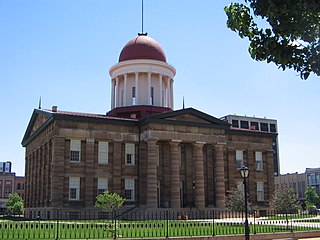
The Old State Capitol State Historic Site, in Springfield, Illinois, is the fifth capitol building built for the U.S. state of Illinois. It was built in the Greek Revival style in 1837–1840, and served as the state house from 1840 to 1876. It is the site of candidacy announcements by Abraham Lincoln in 1858 and Barack Obama in 2007. It was designated a National Historic Landmark in 1961, primarily for its association with Lincoln and his political rival Stephen Douglas.

The Vandalia State House, built in 1836, is the fourth capitol building of the U.S. state of Illinois. It is also the oldest capitol building in Illinois to survive, as the first, second, and third capitol buildings have all disappeared. The brick Federal style state house has been operated by the state of Illinois as a monument of Illinois pioneer years since 1933. It is located in Vandalia, Illinois, on the National Road, and listed on the National Register of Historic Places.

The Lincoln Log Cabin State Historic Site is an 86-acre (0.3 km²) history park located eight miles (13 km) south of Charleston, Illinois, U.S., near the town of Lerna. The centerpiece is a replica of the log cabin built and occupied by Thomas Lincoln, father of U.S. President Abraham Lincoln. Abraham Lincoln never lived here and only occasionally visited, but he provided financial help to the household and, after Thomas died in 1851, Abraham owned and maintained the farm for his stepmother, Sarah Bush Lincoln. The farmstead is operated by the Illinois Historic Preservation Agency.

The Mount Pulaski Courthouse State Historic Site is a historic county courthouse located in Mount Pulaski, Illinois, United States. It was the county seat of Logan County from 1848 until 1855. It is one of only two remaining courthouses from Illinois's Eighth Circuit, the circuit on which central Illinois lawyer Abraham Lincoln carried out much of his practice of law. The courthouse is operated by the Illinois Historic Preservation Agency as a state historic site. Visitors are given guided tours of the recreated county offices and courtroom.
The Postville Courthouse State Historic Site is a replica county courthouse in Lincoln, Illinois, United States. The original frame courthouse was built in 1840 and later moved to Greenfield Village in Michigan; the current courthouse, which is a close replica of the first, was built in 1953. The building's unusual history is derived from its status as one of the courthouses used by lawyer Abraham Lincoln as he traveled the circuit of courtrooms in central Illinois. The courthouse replica is operated by the Illinois Historic Preservation Agency.

The Lincoln Trail Homestead State Park and Memorial is a 162-acre (66 ha) state park located on the Sangamon River in Macon County near Harristown, Illinois, United States.
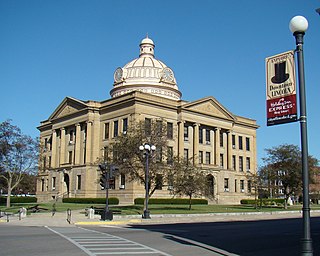
The Lincoln Courthouse Square Historic District is located in Lincoln, Illinois in Logan County. The district is roughly bounded by Sangamon, Pekin, Chicago, Delavan, Broadway, and Pulaski Streets. The district includes 112 buildings, 89 of which are contributing buildings.

Mifflin Emlen Bell, often known as M.E. Bell, was an American architect who served from 1883 to 1886 as Supervising Architect of the US Treasury Department. Bell delegated design responsibilities to staff members, which resulted in a large variety of building styles, including Second Empire, Châteauesque, Queen Anne and Richardsonian Romanesque.

The Wallace Farm is a historic farm at 27 Wallace Road in Columbia, New Hampshire. Established in the late 18th century, the farm has been continuously held in the same family. The 125-acre (51 ha) includes a c. 1825 farmhouse, carriage house, and barn. It was listed on the National Register of Historic Places in 2001.

The Wheeler Family Farmstead is a historic farm complex at 817 South Main Street in Great Barrington, Massachusetts. The farmhouse has elements dating to the 1730s, including evidence of building methods used by Dutch settlers of the Hudson River valley, and has been successively modified in each of the following centuries, with the last significant work occurring in the 1920s. All of the surviving farm buildings in the complex are at least 90 years old, and some date to the 19th century. The property was listed on the National Register of Historic Places in 2011, and is now the museum and headquarters of the Great Barrington Historical Society.
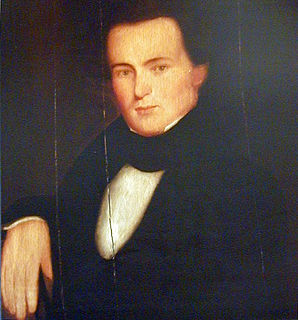
Ossian M. Ross was a pioneer farmer, stock-raiser, and merchant in Illinois, who served as a major in the War of 1812 and subsequently founded the Illinois towns of Lewistown and Havana, and who also played a prominent role in establishing Fulton and Mason counties in that state.

The Black Homestead Farm is a historic farm located west of Carrollton in Greene County, Illinois. Margaret Black, one of the county's first settlers, established the farm in 1821. The farmhouse, built two years later, is the oldest surviving house in Greene County. Architect William Reay designed the brick Federal house, which features a symmetrical plan with evenly spaced windows, an oval fanlight above the original main entrance, and a gable roof with chimneys at each end. A new entrance with a Greek Revival porch was placed on the house in 1855. Other 19th-century farm buildings on the property include a smokehouse, wash house, carriage house, and horse barn. The farm raised livestock and grew grain through the 19th and 20th centuries, as was typical of Greene County farms; it still has active corn and soybean crops.

Isaac Newton Walker was a pioneer farmer and merchant in Illinois, designer of the third Fulton County courthouse, member of the Illinois House of Representatives, and a close personal friend of Abraham Lincoln.

The Taft Farmstead is a historic farm located west of Rochester, Sangamon County, Illinois. Established in the early 20th century, the farm is one of the few intact farmsteads from the period which was not a renovation of an earlier farm. The farm's Classical Revival farmhouse, which dates from 1912, is representative of the spread of individualized architecture to farms; its design includes two-story Doric columns along the front porch and a pyramidal roof with a pediment-like dormer in front. The farm's main barn, a wooden structure used for livestock, was built in 1906. The farm also includes two additional barns, a grain shed, a chicken coop, an outhouse, and a garage.

The Brunk Farmstead is a historic farm located on KOA Campground Road 1 mile (1.6 km) south of East Lake Drive near Rochester, Illinois. George Brunk, an early settler of Sangamon County, established the farm in the 1820s; the farm is one of the few surviving properties from the county's early settlement. The farmhouse was built as a one-story stone structure circa 1829; its second story was added in the 1850s, giving it an I-house plan. While the house originally had a mainly Federal design, it was later updated with Greek Revival and Italianate influences. The original horse barn, the other historically significant building on the property, is a three-bay English barn built in the late 1820s.
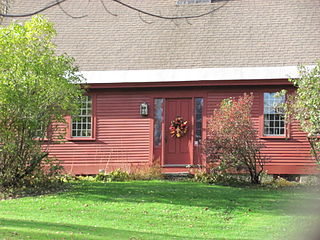
The Atherton Farmstead is a historic farm property at 31 Greenbush Road in Cavendish, Vermont. The farmhouse, built in 1785, is one of the oldest in the rural community, and is its oldest known surviving tavern house. It was listed on the National Register of Historic Places in 2002.



















